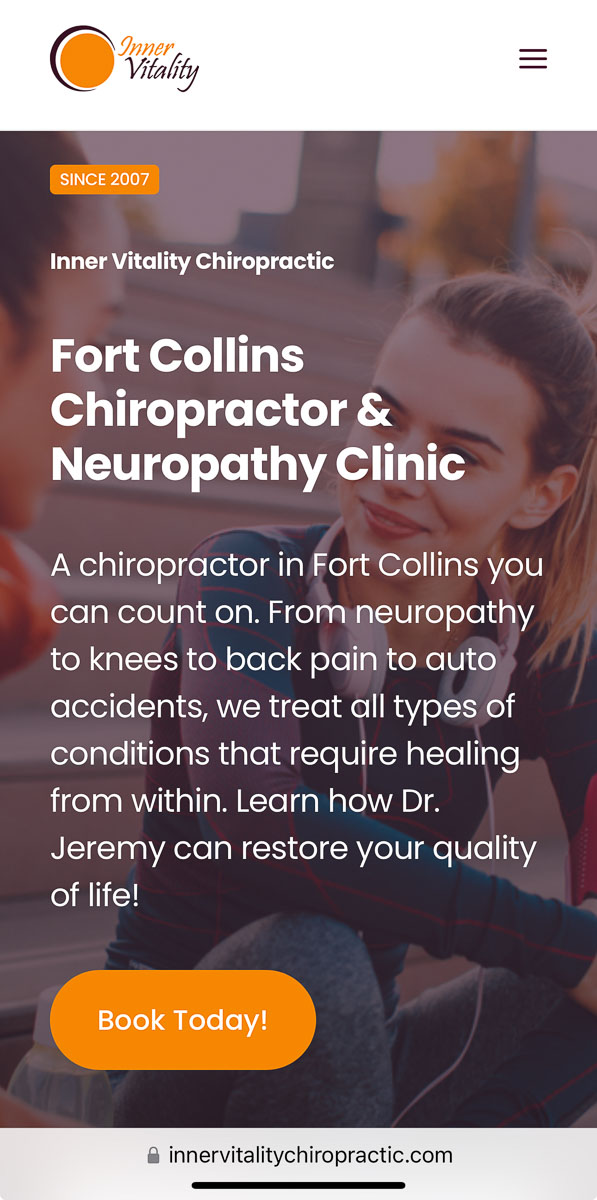In today’s digital age, a well-designed website is crucial for chiropractors looking to attract and retain patients. A high-converting chiropractic website not only showcases your practice but also convinces visitors to choose your services over competitors’.
Here’s a closer look at five essential elements that every chiropractic website should incorporate to maximize conversion rates:
1. Clear and Compelling Call-to-Actions (CTAs)
Effective CTAs are the cornerstone of converting website visitors into patients. They serve as the guideposts that direct visitors towards the next step in their journey with your practice. To maximize their effectiveness, CTAs should be strategically placed throughout your website. Key areas include the homepage, service pages, blog posts, and even the footer. Each CTA should be clearly visible and stand out against the surrounding content, making use of contrasting colors and bold fonts to draw attention.
The language of your CTAs is equally important. Persuasive and action-oriented phrases like “Schedule Your Consultation Today” or “Discover Pain Relief Now” convey a sense of urgency and immediate benefit, prompting visitors to take action. These phrases should be concise and direct, leaving no ambiguity about what the visitor should do next.
 As an example consider Denver Chiropractic LLC, has a clear CTA, which has (1) a button in the navigation bar, (2) a button in the header, links in the header, one for new patient scheduling, one for current patient scheduling and (3) a link to their most important page, Auto Accident Injuries.
As an example consider Denver Chiropractic LLC, has a clear CTA, which has (1) a button in the navigation bar, (2) a button in the header, links in the header, one for new patient scheduling, one for current patient scheduling and (3) a link to their most important page, Auto Accident Injuries.
Positioning CTAs where visitors naturally expect them enhances the user experience and reduces friction. For instance, a CTA to schedule an appointment can be placed at the end of a service description or patient testimonial. Similarly, a newsletter signup prompt can be included within blog posts or as a pop-up after a visitor has spent a certain amount of time on your site. This strategic placement ensures that CTAs are encountered at moments when visitors are most likely to engage.
In addition to the main CTAs, incorporating secondary CTAs can capture different visitor intents. For example, alongside a primary “Book Now” button, you might include a “Learn More” link for those who need additional information before committing. This layered approach caters to various stages of the decision-making process, guiding visitors smoothly from one step to the next and ultimately towards conversion.
2. Patient Testimonials and Success Stories
Potential patients seek reassurance and proof of your expertise before making a decision. Incorporating genuine testimonials and success stories from satisfied patients is a powerful way to build trust and credibility. These testimonials should be detailed and specific, highlighting the unique aspects of their experience with your chiropractic care and the tangible benefits they received.
When sharing patient testimonials, include names and photos (with permission) to add a personal touch and enhance authenticity. Video testimonials can be particularly compelling, as they allow potential patients to hear directly from those who have benefited from your services. These videos can capture the emotional impact of your care, making the testimonials more relatable and persuasive.
Success stories should detail the patient’s initial condition, the treatments provided, and the positive outcomes achieved. This narrative format not only showcases your expertise but also helps visitors connect emotionally and envision themselves experiencing similar benefits. Highlighting a variety of cases—from chronic pain relief to improved mobility—demonstrates your ability to address diverse patient needs.

As an example, Apex Chiropractic uses a Google plug-in to pull its Google Reviews and testimonials onto its site.
Displaying testimonials and success stories prominently on your website, such as on the homepage, dedicated testimonial pages, and service pages, ensures they are easily accessible to visitors. Additionally, integrating them into your marketing materials, such as social media posts and email newsletters, extends their reach and reinforces your practice’s credibility across multiple platforms.
By effectively using patient testimonials and success stories, you create a powerful form of social proof that helps potential patients feel confident in choosing your chiropractic services. This trust-building element, combined with clear and compelling CTAs, forms a robust foundation for a high-converting chiropractic website that drives patient acquisition and retention.
3. Informative Content and Blog
Educational content is a cornerstone of a high-converting chiropractic website, serving dual roles in attracting visitors and establishing your authority in the field. A well-maintained blog with regularly updated articles can significantly enhance your online presence. These articles should address common health concerns, such as back pain, neck pain, and headaches, which many potential patients are likely to experience. Additionally, explaining various chiropractic treatment methodologies, such as spinal adjustments, therapeutic exercises, and lifestyle advice, can demystify your services and make them more approachable.
Wellness tips and preventive care advice further engage visitors, providing them with actionable information that they can implement in their daily lives. Topics like ergonomics, nutrition, and stress management can be particularly valuable, helping you connect with a broader audience interested in overall health and well-being.

As an example, Complete Care Chiropractic uses keywords about a specific condition that can be treated by chiropractic care.
Beyond engaging your audience, informative content plays a crucial role in enhancing your website’s search engine optimization (SEO). By incorporating relevant keywords naturally within your articles, you improve your website’s visibility on search engines. This means potential patients searching for chiropractic care or related health topics are more likely to find your site. The higher your website ranks in search engine results, the more organic traffic you attract, increasing your chances of converting visitors into patients.
Furthermore, by consistently demonstrating your expertise and commitment to patient education, you position yourself as a trusted resource in your field. This trust can be the deciding factor for many potential patients when choosing a chiropractor. They are more likely to book an appointment with a practitioner who is knowledgeable, credible, and genuinely invested in their health and well-being.
4. Mobile-Friendly Design
In today’s digital landscape, a significant portion of web traffic comes from mobile devices. Ensuring your website is fully responsive and optimized for smartphones and tablets is not just a nice-to-have—it’s essential. A mobile-friendly design provides a seamless user experience across all devices, ensuring that visitors can easily navigate your site, access information quickly, and interact with CTAs without any usability issues.
Responsive design means that your website automatically adjusts its layout and content to fit different screen sizes and resolutions. This adaptability is crucial for maintaining a professional and user-friendly appearance on all devices, from desktop computers to smartphones and tablets. A seamless mobile experience improves accessibility, making it easier for visitors to find what they need without frustration.

As an example, the website for Inner Vitality Chiropractic is optimized for mobile usage. Access to the main navigation is on the right-hand side and the CTA buttons are still visible for a quick conversion.
Given that modern consumers often research and book healthcare services on the go, a mobile-optimized website caters to their preferences and behaviors. For instance, a potential patient may search for chiropractors while commuting, during a lunch break, or even from their living room. If your website is not mobile-friendly, you risk losing these visitors to competitors with more accessible and user-friendly sites.
In addition to enhancing user satisfaction, a mobile-friendly design positively impacts your website’s SEO. Search engines like Google prioritize mobile-optimized websites in their rankings, meaning a responsive design can help improve your visibility in search results. This increased visibility can drive more organic traffic to your site, ultimately leading to higher conversion rates.
To ensure your website is mobile-friendly, focus on elements such as easy-to-read text, touch-friendly buttons, and streamlined navigation. Images and videos should load quickly and display correctly on all devices. By prioritizing mobile optimization, you provide a positive user experience for all visitors, regardless of how they access your site. This commitment to accessibility and convenience can set you apart from competitors and help convert more visitors into loyal patients.
5. Online Patient Inquiries
Streamlining the patient booking process is crucial for a high-converting chiropractic website. Offering online appointment scheduling directly from your site significantly enhances the patient experience and reduces barriers to booking. Here’s how it works and why it’s essential:
User-Friendly Scheduling System
Implementing a user-friendly online scheduling system allows patients to book appointments at their convenience. This system should be intuitive and easy to navigate, enabling visitors to select their preferred appointment times with just a few clicks. By providing a clear and straightforward interface, you make the booking process hassle-free, encouraging more visitors to take the next step.
Digital Forms and Confirmation Emails
Incorporating digital forms into your scheduling process allows patients to fill out necessary information before their visit. This step not only saves time during the appointment but also streamlines administrative tasks for your practice. Additionally, sending confirmation emails once an appointment is booked reassures patients that their booking is confirmed and provides them with important details such as the appointment time, location, and any preparatory instructions.
As an example, Freedom Chiropractic has an easy to fill-out online form that goes straight to their inbox. This form allows patients to provide information prior to setting up an initial consultation.
Conclusion
In conclusion, a high-converting chiropractic website combines strategic design elements with persuasive content to attract, engage, and convert visitors into loyal patients. By incorporating clear CTAs, authentic patient testimonials, informative content, mobile-friendly design, and online appointment scheduling, you create a digital presence that not only showcases your practice’s professionalism but also drives growth and patient retention. For chiropractors aiming to maximize their online impact, partnering with a web design expert like Rounded Digital ensures a customized approach that aligns with your practice goals and enhances your online presence effectively.
Where can I find more information about website marketing for a Chiropractor?
4 Ways to Showcase Your Expertise on Your Chiropractic Website
7 Marketing Hacks To Attract More Chiropractic Patients
Visual Appeal Matters: Choosing Images and Videos for Your Chiropractic Website
Nine Marketing Strategies for Chiropractors in 2021
Blogging With Purpose: SEO Content Writing
7 Tips for Developing a Profitable Content Marketing Plan
What Is Pillar Content and Why Do You Need It?
Need advice about an old WordPress build that needs an upgrade? Or maybe you’re ready to build a new site for your business. Either way, let’s talk about how our team can boost your bottom line with affordable digital marketing.

